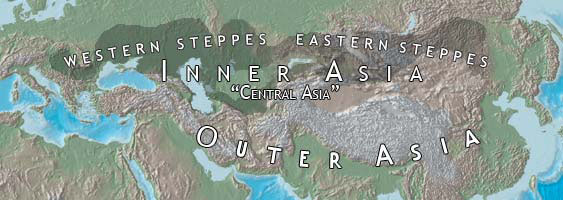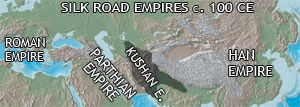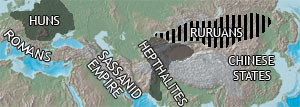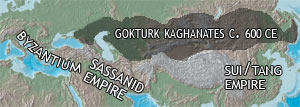- Articles Index
- Monthly Features
- General History Articles
- Ancient Near East
- Classical Europe and Mediterranean
- East Asia
- Steppes & Central Asia
- South and SE Asia
- Medieval Europe
- Medieval Iran & Islamic Middle East
- African History (-1750)
- Pre-Columbian Americas
- Early Modern Era
- 19'th Century (1789-1914)
- 20'th Century
- 21'st Century
- Total Quiz Archive
- Access Account
History of Central Asia - an Overview
By Invictus, January 2006; Revised
Category: Steppes and Central Asia
IntroductionCharacteristics of Central Asian Civilization
The steppes of Inner Asia are vast landscapes abundant in grassland. On these lands, animal herding and domestication became the prevalent way of life. Pastoralism contrasted with the concept of agricultural civilization, such as those of the river valleys regions where permanent, sedentary settlements developed. Instead, the steppes fostered a nomadic lifestyle. Political boundaries were ever-changing and migrations due to power shifts were a reoccurring event on the steppes. However, the destinations of migrating nomadic tribes were not limited to other regions of the steppes; many entered agricultural lands and adopted the lifestyles of sedentary civilization. Thus, the “southern” parts of Central Asia are noted for the presence of sedentary kingdoms, many of which were founded by nomadic conquerors. The invasions and migrations of nomads were an important force in history that greatly affected all parts of Eurasia.
Nomadic states on the steppes relied purely on the skill of their leaders, a quality difficult to consistently maintain. Without strong leadership, these states were usually unstable due to their loose infrastructures and the scarcity of permanent cities. So dynamic were the steppes that vast empires could rise and fall within a generation. However, in their competition against sedentary empires, the lack of internal stability was counterbalanced by ferocity in war. The harshness of life on the steppes made nomads expert warriors and the nomadic lifestyle made them unmatched horsemen. When a strong leader was indeed present, nomadic groups were exceedingly powerful in war. Their prowess in warfare could not be suppressed until the advent of firearms.
As mentioned earlier, nomadic conquerors often forged kingdoms after successful conquests into agricultural lands. The nomadic ruling class of these kingdoms usually adopted the original culture of the conquered region, especially its technologies and agricultural of life.
Influence and Legacy of Central Asian Civilization
The military conquests and migrations of Nomadic peoples were a significant force in history. In the Classical Era (500 BCE -500 CE), groups like the Xiong Nu and the Huns waged destructive wars against China and Rome. The movement of Huns into Europe caused even more migrations of barbarian tribes against Rome. The rise of the Xiong Nu forced the migration of Tocharians, who moved westward and created the Kushan Empire. The Kushan Empire, along with the Parthian Empire, was also an example of agricultural states of nomadic origin. In the classical period, these two particular empires were significant powers and important empires of the Silk Road between China and Rome.
In the Post-Classical Era (500 CE – 1500 CE), the trend of nomadic “border warfare” continued. The Turks warred against China and Europe saw renewed invasion from the steppes. However, migration and settlement in agricultural land became increasingly more significant. Turkic groups later known as the Seljuks migrated into the Middle East, where they played an important role in Islamic civilization. The migration of the Turks into Asia Minor also established the early foundations of the future Ottoman Empire. In the 13th century, the Mongols conquered nearly all of Asia, becoming the ultimate example of nomadic influence on agricultural civilization. Being the first to control significant regions of both outer and inner Asia, the Mongols brought Asia into economic integration by reviving the Silk Road. With nearly all of Asia under Mongol rule, the political state of the continent changed dramatically.
In the Modern Era (1500 CE onward), nomadic civilization slowly faded from being a driving force in history. As firearms developed, nomadic horsemen lost the military prowess that brought them great power. The Mongol states established in the 13th century had almost all disappeared. But even though nomadic powers faded away, many powerful states such as the Mughal, Qing, and Ottoman Empires, all had ruling families whose origins trace back to the steppes.
Culturally, nomadic left a strong impression on the records of their neighboring civilization. The legendary horsemanship of the steppes became the basis of mythological stories such as the centaurs. Likewise, the same horsemanship also had a profound influence on cavalry warfare. Cavalry in Chinese armies was heavily inspired by nomadic tribes to the north. Even for a region as far away as Europe, the origin of heavy cavalry warfare can be traced to nearby pastoralist peoples, namely the Sarmatians.
Finally, the steppes left us with some of the most noteworthy tales from history. Ambitious leaders such as Modu, Attila, Bumin Kaghan, Genghis Khan, Kublai Khan and Tamerlane have left their marks as some of the greatest warriors, king, conquerors, and emperors in history.
Overview of Central Asian historyThe Ancient Steppes
Central Asia has seen human activity since the earliest of time. Although very few permanent agricultural societies grew on the steppes, the people of the steppes mastered the pastoral lifestyle and the domestication of animals. With their horses and herds of livestock, the nomads of Central Asia roamed across the steppes.
In the western steppes the most famous group of early nomads where the nomads of "Scythia," a loosely defined region spanning from the Black Sea to Eastern Mongolia. From the 8th century BCE onward, the Scythians waged war with neighboring civilizations such as the Persians, Greeks, and Mesopotamians. The Scythians were renowned for their superb horsemanship, a characteristic common among all nomadic groups.
In the 6th Century BCE, the Achaemenid Persian Empire and later, Alexander’s Empire, expanded into the edges of the western steppes. At the edges of these two empires, the result was a mixing of nomadic and sedentary cultures. Perhaps the greatest example of such multiculturalism is the Kushan Empire of the 1st to 3rd century CE, an empire built by migrating nomads who integrated Greek, Persian, and Indian cultures that had become local of the area. Despite their nomadic origin, the Kushans built an empire of walled cities and agriculture, suitable for the region. West of the Kushan Empire was the Parthian Empire, which conquered Persia from Alexander’s successors. Like the Kushan Empire, the Parthian Empire was a sedentary kingdom whose rulers were of nomadic origin. Establishment of “civilized” kingdoms by “barbarian” nomads would prove to be a reoccurring theme in history. Further north from these kingdoms, pastoral nomads still roamed the land.
The eastern steppes saw no less activity than the western steppes. Like the nomads of the western steppes, the nomads of the east were in frequent contact with nearby civilizations, namely the Chinese. The famous Great Wall of China was built as defense against these invaders from the north. In the 200s BCE, the Xiong Nu rose to prominence under their leader Mao Dun. The Xiong Nu conquered a large region around Mongolia and grew into a powerful confederation. Nearby nomads were incorporated into the empire or driven out. One particular group who fled the Xiong Nu onslaught was the Yue Zhi, who later founded the Kushan Empire far away from their original homeland. As the most powerful nomadic empire the world had yet seen, the Xiong Nu aggressively waged war against China, now under the rule of the Han Dynasty. However, the fragile state of nomadic empires could not maintain their conquests in China. Eventually, the Xiong Nu was defeated. Later, punitive expeditions from the Han broke the Xiong Nu Empire into fragmented states. The Xiong Nu fell into tributary status and eventually continued to decline. By the second century AD, the Xiong Nu was no longer a significant force.
At this time in history (c. 100 AD), four great empires spanned Eurasia: The Roman Empire, the Parthian Empire, the Kushan Empire and the Han Empire. Of these four empires,the Parthian and Kushan Empires were both of nomadic origins. Through these empires ran the famous Silk Road, the major inter-continential trade route of its time. While nomads are often known for war, at many times, they were peaceful. They were present on trade routes, often acting as middlement for far-away merchants.
In China, the collapse of the Xiong Nu created opportunities for emerging powers in the steppes. When the Han Dynasty also fell, northern China became an easy target for nomadic conquerors. A new group, the Xianbei, had already risen to power. In 386 AD, a division of the Xianbei established the Northern Wei Dynasty in Northern China, another example of an agricultural empire of nomadic origin. Interestingly, on the steppes, the Xianbei were replaced by another power, the Ruruan. The Ruruan became the newest to hold the ever-changing position of “Empire of the Steppes,” until they were overthrown in the 6th century.
Other Parts of the world faced similar incursions by nomadic groups. In 370, the Huns arrived near the black sea, where they displaced the Goths and other barbarians of the area. (The fact that the Huns appeared at a time approximately after the Xiong Nu disappeared has encouraged the notion that the Huns came from the Xiong Nu.) The expansion of the Huns forced other barbarians into Roman realms. The result of was devastating to the Roman Empire. The Hunnic Empire, a conglomerate of barbarian tribes ruled by the Huns, reached their peak of power in the 450s under their king Attila. But after Attila died, the empire rapidly disintegrated. Another invading group of this time was the Hepthalites, who were driven out from Mongolia by the rising Ruruan power. Forced to migrate, the Hepthalites moved west and destroyed the already fragmented Kushan Empire. The Helphalites expanded further, attacking the Sassanid Empire of Persia and expanding into India.
The Episodes of the Scythians, Xiong Nu, Huns, and other nomads show a trend of continual change. On the steppes, the scarcity of permanent cities meant that empires were constantly built and destroyed, and that groups migrate at the dynamics of these power shifts. Steppe peoples such as the Xiong Nu waged wars with their neighboring agricultural empires, but also served as traders. Furthermore, empires like the Kushans’ show that nomads were also capable of building sedentary empires of cities and agriculture. In the next “period” of history, marked by the movement of Turks and Mongols, such trends become even more dramatic.
Turkic Empires: the Early Post-Classical Era (500-1200 CE)
In 552 AD, the Ruruan Empire collapsed at the uprising of the Gokturks (“Tu-Jue” in Chinese). Under their Kaghan Bumin and his successors, the Gokturks expanded rapidly to encompass all of greater Mongolia, the lands westward to the Caspian Sea and the lands eastward to Korea. The Gokturks built the most significant steppe empire so far in history, holding large areas of both the eastern and western steppes. The Gokturks destroyed the Hepthalite Empire and waged wars against China and even against Sassanid Iran. However, the vast empire could not maintatin its stability, and split into eastern and western divisions. Both empires were weakened by internal instability and eventually defeated in 630 by Tang China, which soon regained control of the Silk Road. The eastern empire was revived under new leadership and lasted until its collapse in 744 AD. Even though the Gokturk Kaghanate disappeared, the term “Turk” was passed on to many subsequent Turkic-speaking peoples of Eurasia, including the future Seljuk Turks. The immediate successor to the Gokturk Empire in the east was the Uyghurs. The Uyghurs, another Turkic-speaking people, were once subjects to the Gokturks. As the second Gokturk Empire declined, the Uyghurs seized power in the region. By the 760s, the Uyghur had renewed most of the former power of the Gokturks while the Tang Dynasty faced rebellion and began declining. However, the Uyghurs fell into disunity by the 830s AD and collapsed. Following the collapse of the Uyghur Kaghanate, many smaller kingdoms appeared in the area, but no extensive empire would rule the Eastern Steppes until the Mongols of the 13th century.
The successors of the Gokturks in the west were the Bulgars and the Khazars. The Khazars foraged a strong khanate in the region between the Black and Caspian Sea. The Khazarians kingdom became dominant over the Bulgars and became the major power of the region. The Khazars were also notably unique in their adoption of Judaism as their religion. West of the Khazars, the Steppes near Europe continued to see dynamic influences from the steppes in the form of migrations. One remnant of the Bulgars migrated from the steppes and formed a state near the Danube, north of the Byzantine Empire. The Danube Bulgars would become a significant power in the 9th century. Around that time, one century after the abrupt collapse of the Hunnic Empire, the Avars invaded Europe from the steppes. The Avars launched punitive campaigns into central Europe and until settling in Pannonia in the late 500s AD. Avar power continued in Pannonia, where it dwindled in influence until the Avar state was annexed by Charlemagne. Incursions from the steppes resumed in 896, when the Magyars entered the Hungarian plains, from where they launched expeditions into other parts of Europe. After the raids, the Magyars settled permanently in the Hungarian Plains. While nomadic conquests were rather frequent in outer Asia and Eastern Europe, Western Europe proved to be too far from the steppes for sustained nomadic incursions.
The Seljuk Empire was the largest empire in outer Asia that had its origins from inner Asia. However, the empire only lasted about a century. In 1156, the empire collapsed under a series of revolts. Of the many kingdoms that splintered out of the Seljuk Empire, one of the most notable was the Sultanate of Rum in Anatolia, which laid the foundation for future Turkish states of Turkey. As noted earlier, following the collapse of the Uyghur Kaghanate in the eastern steppes, no large nomadic empire could dominate the entire region. New kingdoms appeared in the region and surrounding areas. In the far eastern regions of the Mongolia steppes, the Khitans rose to prominence with their establishment of the Liao Dynasty in 907 in Eastern Mongolia and parts of Northern China. The Khitans were a Tungusic nomadic group, distinct from Turkic nomads and possibly related to the old Xianbei. In 1125, The Khitans were driven out into Central Asia by the Jurchen, another Tungusic group, who proved to be a formidable war machine. The Jurchen aggressively waged war with the Song Dynasty of China. Their powerful cavalry gave them the upper hand against the Song. The Jurchen captured a significant portion of Northern China, forcing the Song to relocate their capital south. Like many nomadic conquerors, the Jurchen established themselves into local customs, adopting the Chinese Dynastic name of Jin. As lord of Northern China, the Jin saw the steppes nations as their subjects. But the Jin would eventually be overthrown by a new steppe empire. The Mongol Conquests: Central Asia from 1200-1500 In 1206, an ambitious warlord named Temujin united the Mongolian steppes under his command. He became Chinggis (Genghis) Khan. Chinggis launched campaigns against the Jin Empire, subjugated the Xixia west of the Jin and conquered the Khwarezmian Empire, which ruled the western territory of the former Seljuk Empire. His successor continued this line of spectacular conquests. The Jin Empire finally fell in 1234 and the Mongols extended their empire westward, incorporating the Sultanate of Rum, all of the western steppes and most of Russia by the 1240s. Further conquests annexed Southwest Asia, cumulating in the capture of Baghdad and the destruction of the Abassid Caliphate. Chinggis’ grandson Kublai completed the conquest of China with the establishment of the Yuan Dynasty in 1271 and the final destruction of the Song Dynasty in 1279. By 1280s, the Mongol Empires ruled nearly all of Asia, from the Pacific Ocean to Asia Minor. Although the Mongols had already begun to lose unity by 1260 when individual Khanates gradually became increasingly dependent, the unprecedented magnitude of the Mongol conquests had far-reaching consequences. While earlier nomadic powers had either built vast empires on the steppes of Inner Asia or powerful empires in agriculture lands of outer Asia, the Mongols were the first to hold both Inner and Outer Asia. As a result, the boundary between the regions of Persia and the Western Steppes, and the boundary between China and the Eastern Steppes, as well as the regions of Asia Central all disappeared under the overreaching dominion of the Mongols. Trade was able to flourish between the east and the west, and for the first time since the fall of the Tang Empire, the Silk Road was reopened. On the newly opened trade route, ideas and even diseases were able to be exchanged from one side of Eurasia to another. The massive political realignment also had dramatic consequences on the civilizations of Asia. The conquest of China brought about a reunification of the region under a single dynasty, although a foreign one. The establishment of Mongol power in Russia drastically changed the political situation of the former disunited states in the region. The establishment of rule in Persia and the Middle East brought Islam rule in the region to brief halt. The extent of the Mongol conquest was limited by the Mongols’ growing disunity due to the geographic overextension of the empire. As disunity increases, the Mongols increasingly lost the resources for further conquest. When Kublai died in 1294, no Great Khan was recognized as at least the nominal overlord of the Mongol Dominions. The western divisions of the Mongol Empire, the Il-Khanate and the Blue Horde, fought for power only to dilute each other’s strength. The Il-Khanate waged war with the Mameluks, who had grown into a powerful force, but were not successful. Despite failures to further expand into the Middle East, the Il-Khanate remained as a formidable state until its collapse in 1335, after which the region fell into a state of Chaos. Power was restored later by the Turkic conqueror Timur Lenk (Tamerlane). Timur ruthlessly defeated all his adversaries. The Mongol Khans in Russia, the Ottoman Turks, the Mameluks, the Delhi sultanate were all defeated. With the Central Asian city of Samarkand as capital, Timur’s empire is sometimes considered to be the last great “nomadic” power of the western steppes. However, the empire was short lived and disintegrated a century after he died death in 1405. After the fall of Timur’s Empire, the Safavid dynasty rose in Iran. Native rule and Islam were restored and never again would a power derived from the steppes hold power in the region. The 16th Century and Onwards Shortly after the collapse of the Il-Khanate, the Mongols also lost hold of China when the Yuan Dynasty was overthrown in 1368 in favor of the Ming Dynasty. The the Ruling line of the Yuan Dynasty retreated back to Mongolia. Despite being expelled, the Mongols were still a formidable power in war. In 1449, the Mongols were able to capture the Ming Emperor in an exceedingly disastrous campaign for the Ming. Continuing threats from the Mongols had already encouraged the rebuilding of the Great Wall of China by the Ming, whose version of the wall is well-known today. Nonetheless, the Mongols were no longer able to stage any permanent conquests of China. In Russia, the Mongol Khans of the Blue Horde and the later Golden Horde had established themselves as overlords as a result of their successful conquests. The Russian principalities became tributary states to the Mongol Khanates. However, by the 15th century, Mongol grip on Russia had gradually weakened, while the Russian states became increasingly more powerful. In 1380, the Russians defeated the Golden Horde, which afterward, fragmented to a collection of states. By 1503, the Russian principality of Muscovy under Ivan the Great had definitively thrown off Mongol rule. Muscovy began its own campaigns of expansion into Central Asia. One fragment of the Golden Horde, the Khanate of Crimea, survived until 1789. In the 17th the semi-nomadic Manchus swept down from the steppes east of Mongolia and conquered the Ming. Led by Nurrhacci and his successors, the Manchu conquered Ming China. Manchu conquests represented the last major conquest by a nomadic horseman. Like all foreign conquerors of China, the Manchus became a Chinese Empire, taking the dynastic title of Qing. The Manchus then launched aggressive campaigns against their neighbors. In 1634, the last Mongol Great Khan surrendered to the Manchu. Meanwhile, the Russians continued their impressive expansion into Central Asia. On the eastern steppes, the lands not conquered by the Qing were taken by the Russians. By the 19th century, the Russians had annexed almost of the western steppes. While Central Asia was still Central Asia, the world has dramatically changed as time moved into the “Modern” period. Though successful for thousands years, nomadic cavalry warfare could no longer maintain its edge against firearms. The rising global presence of “agricultural” states became too difficult for nomadic armies to “sweep and conquer.” Power became more of a matter of economical prowess rather than the skill of individual warriors. Into the modern era, nomadic civilization ceased to be a driving force in history.
SELECTED REFERENCES
Nicolle and Shpakovsky, Kalkha River 1223. Oxford: Osprey Publishing, 2001. Map of steppe climate zones. Ihsan, various articles on www.allempires.com. For reference on Turkic History Christian, A history of Russia, Central Asia, and Mongolia. Blackwell Publishers, 1999. Author: Imperator Invictus Written: Jan. 2006 |






